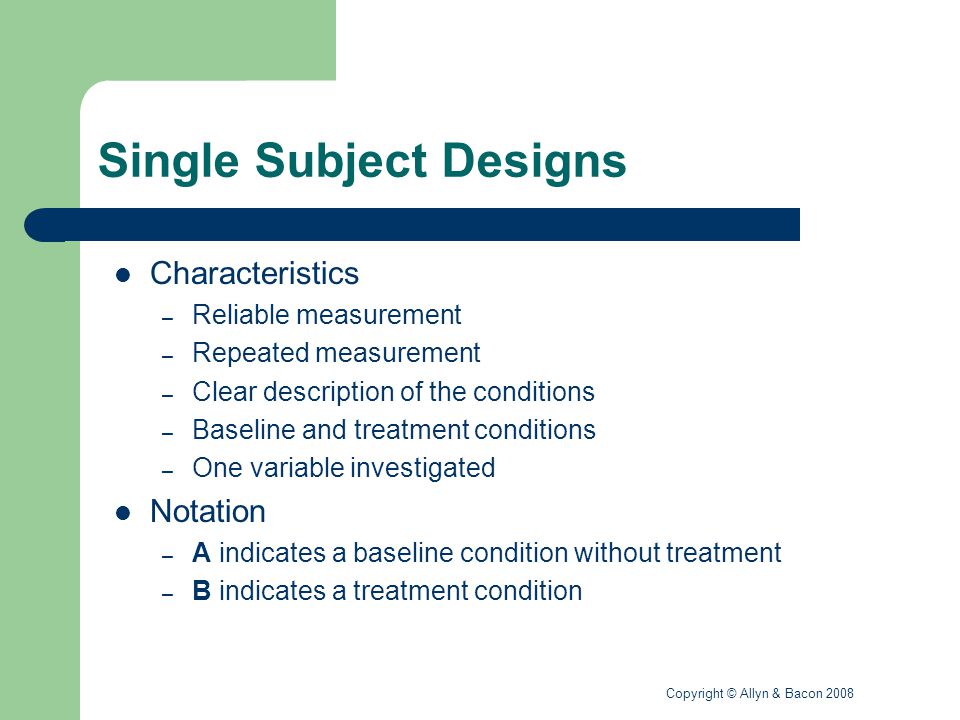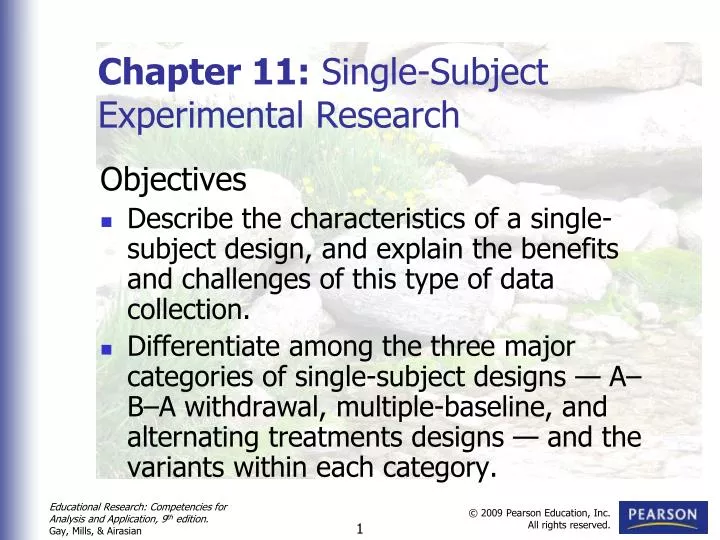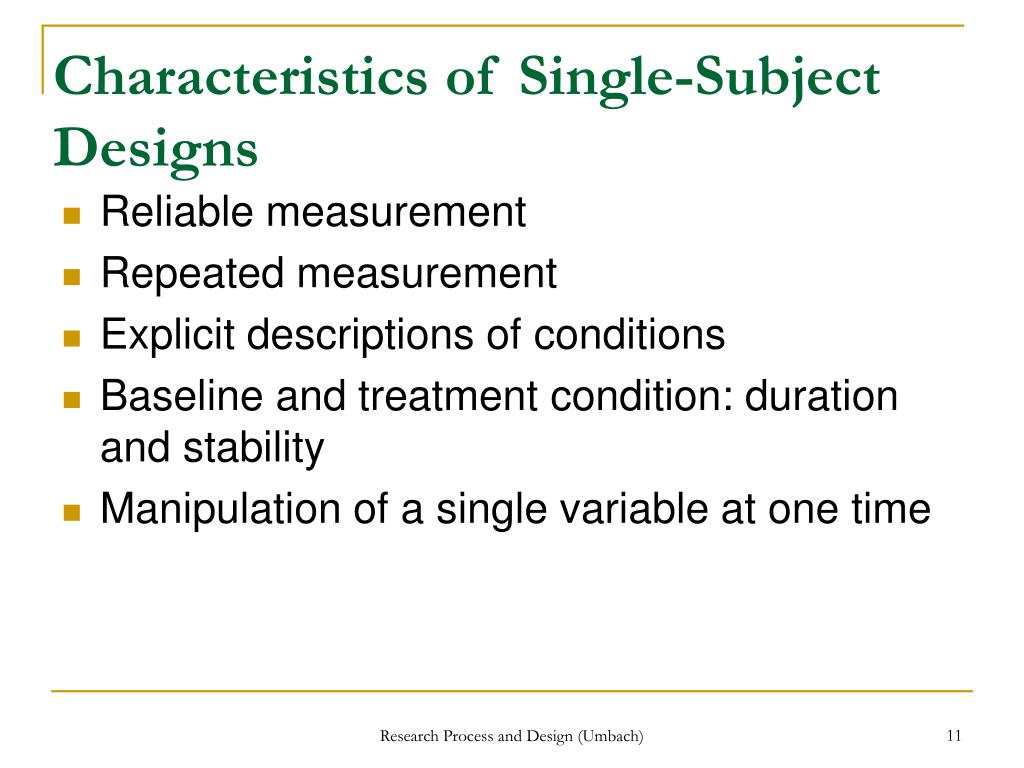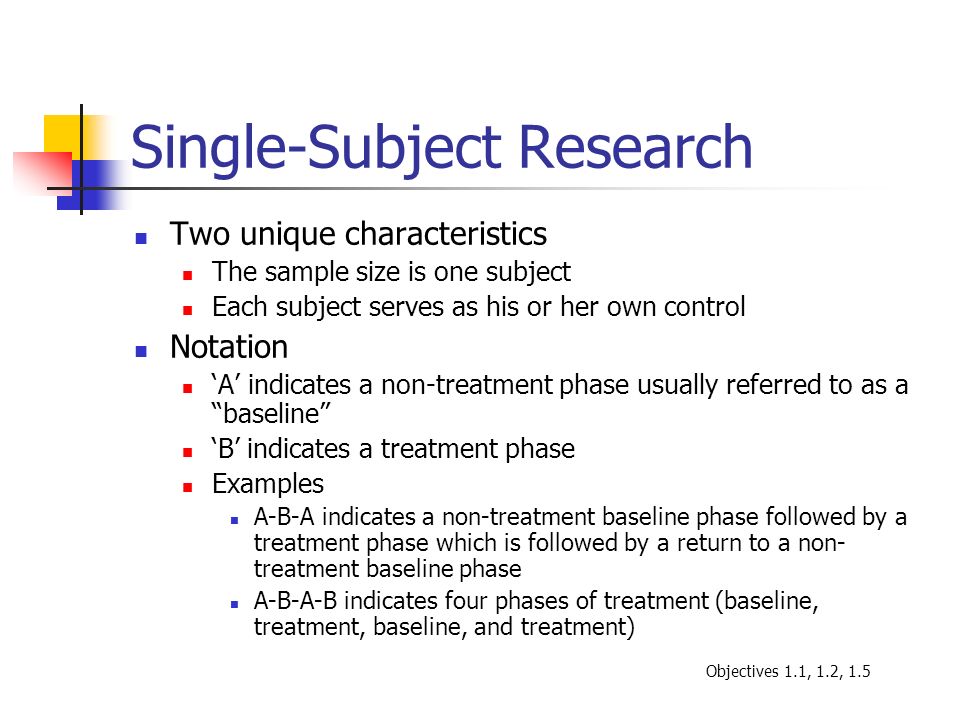Single-subject research is a type of quantitative research that involves studying in detail the behaviour of each of a small number of participants. Benefits of Single Subject Design Study low incidence populations and behaviors Cost effective Evaluate intervention prior to large scale study Flexible design is adaptable to situation Can be conducted in practice settings Test clinical hypotheses Monitor progress in applied settings Limitations of Single Subject Design.

Experimental Research Designs Ppt Video Online Download
In design of experiments single-subject curriculum or single-case research design SCED is a research design most often used in applied fields of psychology education and human behavior in which the subject serves as hisher own control rather than using another individualgroup.

. This flexibility allows progress to be evidence-based practices. The case provides its own control for purposes of comparison. Researchers use single-subject design because these designs.
Two or more treatments are alternated relatively quickly on a regular schedule. In a between-subjects design or a between-groups design every. Coded variables included the specific kind of design number of cases per study number of outcomes data points and phases per.
It is essential for educators to understand the characteristics. The purpose of this article is to review the strategies and tactics of SSEDs and their application in speech-language pathology research. An individual case is the unit of intervention and unit of data analysis.
Single-subject experimental designs SSEDs represent an important tool in the development and implementation of evidence-based practice in communication sciences and disorders. Characteristics of Single-Subject experimental designs SSEDs Small number of participants Importance of individual differences. Since the foundational base was provided singlecase designs have proliferated especially in areas of application where they have been used to evaluate interventions with an extraordinary range of.
Tactics of Scientific Research Sidman 1960 provides a visionary treatise on singlecase designs their scientific underpinnings and their critical role in understanding behavior. A small number of participants b repeated measurement of the dependent variable c logical generality d positive correlation e visual inspection of data. Between-Subjects Design Examples Pros Cons.
The phases of a single-subject design are almost always summarized on a graph. Single Subject Research Designs SSRDs work by designing an experiment where instead of a control group of subjects and an experimental group of subjects whose results are compared to one another the control and experimental measurements come from a single subject. Single-subject designs appropriate for the needs of the special education field.
Do not have adequate control for the factors that affect the internal validity of an experiment AB design - ONLY pre-experimental design. Introducing the Single-Case Experimental Design SCED Scale. Single-subject designs are defined by the following features.
Logan LR Hickman RR Harris SR Heriza CB. The y axis is used to represent the scores of the dependent variable whereas the x axis represents a unit of time such as an hour a day a week or a month. A single-subject research design in which multiple treatments are alternated rapidly on a regular schedule.
Up to 10 cash back This article reports the results of a study that located digitized and coded all 809 single-case designs appearing in 113 studies in the year 2008 in 21 journals in a variety of fields in psychology and education. Graphing the data facilitates monitoring and evaluating the impact of the intervention. Single-subject designs reflect the tenets of educational psychology that emphasise each students individualised learning needs and allow for simple methods of data collection and analysis Forbes et al Reference Forbes Ross and Chesser 2011Single-subject designs are primarily used to examine the existence of a causal or functional relationship.
In experiments you test the effect of an independent variable by creating conditions where different treatments eg. The same behavior is measured repeatedly. Logan et al scales.
Characteristics of Single-SubjectSystem Designs According to Kratochwill and Williams 1988 single-case experimental designs have following five characteristics. First single-subject designs are focused on individual level and do not require populations. If a true single-blind study is performed.
Before looking at any specific single-subject research designs it will be. Single-Subject Research Designs General Features of Single-Subject Designs. Rating the methodological quality of single-subject designs and n-of-1 trials.
All of the following are characteristics of single-subject experimental designs SSEDs except. Since these designs contain many measures of behavior it is important to have reliable. Another advantage of using single-subject designs is the Single-subject designs are a rigorous scientific methodol- flexibility of these designs to adapt to varying situations and ogy used to define basic principles of behavior and establish educational settings.
During the first phase A a is established for the dependent variable. Data collected prior to during and following the intervention allow measurement of changes. Note that the term single-subject does not mean that only one participant is studied.
This is why single-subject research. For example positive attention for studying could be used one day and mild punishment for not studying the next and so on. What Is Single-Subject Research.
The results of Edgington designs permit a causal interpretation if the subjects cannot discriminate the different experimental conditions ie. For example the cases series of outcome. This understanding will allow.
The researcher repeatedly assesses the DV across various phases of the experiment. 3 Description of. The performance of a double-blind study where the experimenter cannot discriminate the conditions either is even better.
Single subject research designs are weak when it comes to external validityStudies involving single-subject designs that show a particular treatment to be effective in changing behavior must rely on replicationacross individuals rather than groupsif such results are be found worthy of generalization Fraenkel Wallen 2006 p. It is more typical for there to be somewhere between two and 10 participants. Characteristics of single subject design 1 Reliable measurement.
Published on March 12 2021 by Pritha BhandariRevised on September 3 2021. A placebo pill vs a new medication are applied. Tate RL McDonald S Perdices M Togher L Schulz R Savage S.
This is the level of. This phase is different from most experiments in.

Single Subject Design Ppt Download

Ppt Chapter 11 Single Subject Experimental Research Powerpoint Presentation Id 4529481

Ppt Experimental Research Designs Part 2 Powerpoint Presentation Free Download Id 315673

Quasi Experimental And Single Case Experimental Designs Ppt Download

Single Subject Experimental Research Ppt Video Online Download

Single Subject And Correlational Research Bring Schraw Et Al Ppt Download

Ppt Single Subject Research Design In A School System Powerpoint Presentation Id 726774

0 comments
Post a Comment